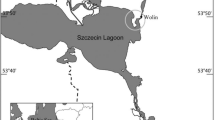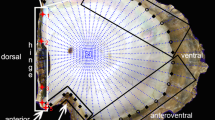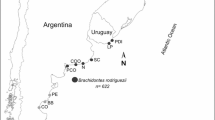Abstract
The pattern of shell shape variation in populations of the mussel, Mytilus chilensis (Hupe 1854) from Southern Chile was analyzed as a function of sample origin (cultivated vs. wild) and latitude, using standard tools of geometric morphometrics for landmark data. Additionally, posterior adductor muscle index (PAMI), Freeman condition index and shell thickness were measured in each sample. Highly significant differences in shell shape components were found among mussel populations. These differences are related to the origin of samples (expansion of the posterior adductor muscle scar, elongation of the lateral ligament and of the ventral umbo position in non-cultivated samples) and to latitude (more elongated shells and more extended posterior adductor muscle scar in most southern samples when compared with the northernmost ones). PAMI and shell thickness were statistically higher in wild population, and Freeman condition index was higher in cultivated shells. It is suggested that in wild populations of M. chilensis, the mussels may face higher predator pressures and other environmental stress factors. Consequently, individuals may be using higher energy fraction to reinforce shells and to promote adductor muscle growth at the expense of somatic growth. In contrast, individuals found in calm aquaculture environments are relatively protected from predators and use most of their assimilated energy in somatic growth. In turn, this growth depends on changes that covariate with shell morphology.





Similar content being viewed by others
References
Aguirre M, Pérez S, Sirch Y (2006) Morphological variability of Brachidontes Swainson (Bivalvia, Mytilidae) in the marine Quaternary of Argentina (S.W. Atlantic). Palaeogeogr Palaeoclimatol Palaeoecol 239:100–125. doi:10.1016/j.palaeo.2006.01.019
Alunno-Bruscia M, Bourget E, Fréchette M (2001) Shell allometry and length-mass-density relationship for Mytilus edulis in an experimental food-regulated situation. Mar Ecol Prog Ser 219:177–188
Beadman H, Caldow R, Kaiser M, Willows R (2003) How to toughen up your mussels: using mussel shell morphological plasticity to reduce predation losses. Mar Biol 142:487–494. doi:10.1007/s00227-002-0977-4
Bertness M, Grosholz E (1985) Population dynamics of the ribbed mussel, Geukensia demissa: the costs and benefits of an aggregated distribution. Oecologia 67:192–204
Bookstein F (1991) Morphometrics tools for landmark data: geometry for biology. Cambridge University Press, Cambridge
Briones C, Guiñez R (2005) Asimetría bilateral de la forma de las valvas y posición espacial en matrices del chorito Perumytilus purpuratus (Lamarck, 1819) (Bivalvia: Mytilidae). Rev Chil Hist Nat 78:3–14
Caro A, Castilla J (2004) Predator-inducible defences and local intra-population variability of the intertidal mussel Semimytilus algosus in central Chile. Mar Ecol Prog Ser 276:115–123
Castro H (2007) Biología marina. McGraw-Hill, Madrid
Clasing E, Oñate A, Arriagada H (1998) Cultivo de Choritos en Chile. Universidad Austral de Chile, Imprenta Universitaria S.A., Valdivia
Costa C, Menesatti P, Aguzzi J, D’Andrea S, Antonucci F, Rimatori V, Pallottino F, Mattoccia M (2008) External shape differences between sympatric populations of commercial clams Tapes decussatus and T. philippinarum. Food Bioprocess Technol. doi:10.1007/s11947-008-0068-8
Dávila PM, Figueroa D, Müller E (2002) Freshwater input into the coastal ocean and its relation with the salinity distribution off austral Chile (35–55°S). Continental Shelf Res 22:521–534
Filgueira R, Labarta U, Fernández-Reiriz M (2008) Effect of condition index on allometric relationship of clearance rate in Mytilus galloprovincialis Lamarck, 1819. Revista de Biología Marina y Oceanografía 43:391–398
Funk A, Reckendorfer W (2008) Environmental heterogeneity and morphological variability in Pisidium subtruncatum (Sphaeriidae, Bivalvia). Internat Rev Hydrobiol 93:188–199. doi:10.1002/iroh.200710969
Grefsrud E, Strand Ø (2006) Comparison of shell strength in wild and cultured scallops (Pecten maximus). Aquaculture 251:306–313. doi:10.1016/j.aquaculture.2005.06.004
Innes D, Bates J (1999) Morphological variation of Mytilus edulis and Mytilus trossulus in eastern Newfoundland. Mar Biol 133:691–699
Kirk M, Esler D, Boyd W (2007) Morphology and density of mussels on natural and aquaculture structure habitats: implications for sea duck predators. Mar Ecol Prog Ser 346:179–187. doi:10.3354/meps07046
Koehn R, Newell R, Immermann F (1980) Maintenance of an aminopeptidase allele frequency cline by natural selection. Proc Natl Acad Sci USA 77:5385–5389
Krapivka S, Toro J, Alcapán A, Astorga M, Presa P, Pérez M, Guiñez R (2007) Shell-shape variation along the latitudinal range of the Chilean blue mussel Mytilus chilensis (Hupe 1984). Aquacult Res 38:1770–1777. doi:10.1111/j.1365-2109.2007.01839.x
Lafrance M, Cliche G, Haugum G, Guderley H (2003) Comparison of cultured and wild sea scallops Placopecten magellanicus, using behavioral responses and morphometric and biochemical indices. Mar Ecol Prog Ser 250:183–195
Lajtner J, Marušić Z, Klobučar G, Maguire I, Erben R (2004) Comparative shell morphology of the zebra mussel, Dreissena polymorpha in the Drava river (Croatia). Biologia Bratislava 59:595–600
Lancelloti D, Vásquez J (2000) Zoografía de macroinvertebrados bentónicos de la costa de Chile: contribución para la conservación marina. Rev Chil Hist Nat 73:99–129. doi:10.4067/S0716-078X2000000100011
Lovatelli A, Farías A, Uriarte I (eds) Estado actual del cultivo y manejo de moluscos bivalvos y su proyección futura: factores que afectan su sustentabilidad en América Latina. Taller Técnico Regional de la FAO. 20–24 de agosto de 2007, Puerto Montt, Chile. FAO Actas de Pesca y Acuicultura, No. 12. Roma, FAO, 359 p
Palmer M, Pons G, Linde M (2004) Discriminating between geographical groups of a Mediterranean commercial clam (Chamelea gallina (L): Veneridae) by shape analysis. Fish Res 67:93–98. doi:10.1016/j.fishres.2003.07.006
Reid D, Osorio C (2002) The shallow-water marine Mollusca of the Estero Elefantes and Laguna San Rafael, southern Chile. Bull Nat Hist Mus, London (Zool) 66:109–146
Reimer O, Harms-Ringdahl S (2001) Predator-inducible changes in blue mussels from the predator-free Baltic Sea. Mar Biol 139:959–965
Reimer O, Tedengren M (1996) Phenotypical improvement of morphological defences in the mussel Mytilus edulis induced by exposure to the predator Asterias rubens. Oikos 75:383–390
Rohlf FJ (2003a) tpsRelw, relative warps analysis, version 1.36. Department of Ecology and Evolution, State University of New York, Stony Brook
Rohlf FJ (2003b) tpsRegr, shape regression, version 1.28. Department of Ecology and Evolution, State University of New York, Stony Brook
Rohlf FJ (2005) tpsDig, digitize landmarks and outlines, version 2.05. Department of Ecology and Evolution, State University of New York, Stony Brook
Rufino M, Gaspar M, Pereira A, Vasconcelos P (2006) Use of shape to distinguish Chamelea gallina and Chamelea striatus (Bivalvia: Veneridae): linear and geometric morphometric methods. J Morphol 267:1433–14440. doi:10.1002/jmor
Sälgeback J (2006) Functional morphology of gastropods and bivalves. Digital Comprehensive Summaries of Uppsala Dissertations from the Faculty of Science and Technology 257, Universitatis Upsaliensis, 31 pp
Sernapesca (2009) Norm LAB NT1 http://www.sernapesca.cl/index.php?option=com_remository&Itemid=246&func=fileinfo&id=198
Sernapesca Annual Report (2008) http://www.sernapesca.cl/index.php?option=com_remository&Itemid=54&func=fileinfo&id=3302
Shurova N (2001) Influence of salinity on the structure and the state of bivalve Mytilus galloprovincialis populations. Russ J Mar Biol 27:151–155
Soto R (1996) Estructura gremial de un ensamble de depredadores de la zona intermareal rocosa en Chile Central. Invest Mar 24:97–105
Soto R, Castilla J, Bozinovic F (2004) Conducta de forrajeo del gastrópodo Acanthina monodon Pallas, 1774 (Gastropoda: Muricidae) en el intermareal rocoso de Chile central. Rev Chil Hist Nat 77:157–175. doi:10.4067/S0716-078X2004000100012
Sousa R, Freire R, Rufino M, Mendez J, Gaspar M, Antunes C, Guilhermino L (2007) Genetic and shell morphological variability of the invasive bivalve Corbicula fluminea (Müller, 1774) in two Portuguese estuaries. Estuar Coast Shelf Sci 74:166–174. doi:10.1016/j.ecss.2007.04.011
Steffani C, Branch G (2003) Growth rate, condition, and shell shape of Mytilus galloprovincialis: responses to wave exposure. Mar Ecol Prog Ser 246:197–209
Toro J, Castro G, Ojeda J, Vergara A (2006) Allozymic variation and differentiation in the Chilean blue mussel, Mytilus chilensis, along its natural distribution. Genet Mol Biol 29:174–179
Ubukata T (2003) A morphometrical study on morphological plasticity of shell form in crevice-dwelling Pterioida (Bivalvia). Biol J Linn Soc 79:285–297
Viðarsdóttir U, O′Higgins P, Stringer C (2002) A geometric morphometric study of regional differences in the ontogeny of the modern human facial skeleton. J Anat 201:211–229
Young R (1941) The distribution of the mussel (Mytilus californianus) in relation to the salinity of its environment. Ecology 22:379–386
Zelditch M, Swiderski D, Sheets H, Fink W (2004) Geometric morphometrics for biologists. Elsevier Academic Press, New York and London
Acknowledgments
Partial support was obtained from International Atomic Energy Agency Technical Cooperation Grant CHI 07/011 to B.A.S.I. and Fondecyt 1050279 to G.M.
Author information
Authors and Affiliations
Corresponding author
Additional information
Communicated by F. Bulleri.
Rights and permissions
About this article
Cite this article
Valladares, A., Manríquez, G. & Suárez-Isla, B.A. Shell shape variation in populations of Mytilus chilensis (Hupe 1854) from southern Chile: a geometric morphometric approach. Mar Biol 157, 2731–2738 (2010). https://doi.org/10.1007/s00227-010-1532-3
Received:
Accepted:
Published:
Issue Date:
DOI: https://doi.org/10.1007/s00227-010-1532-3




